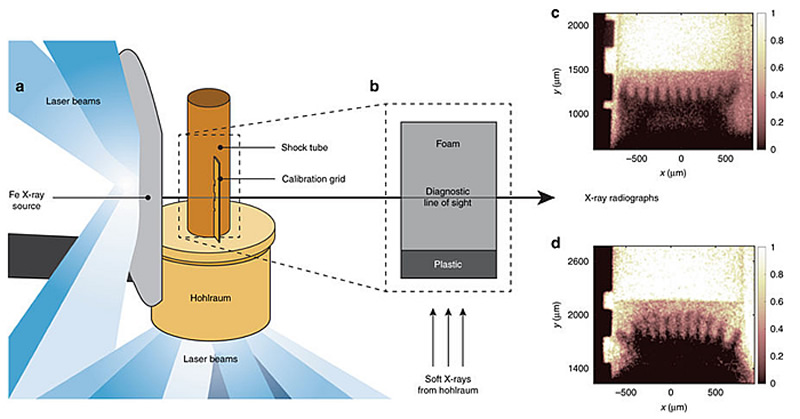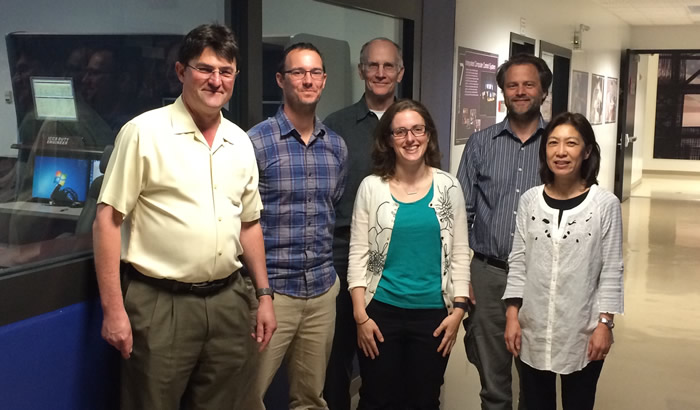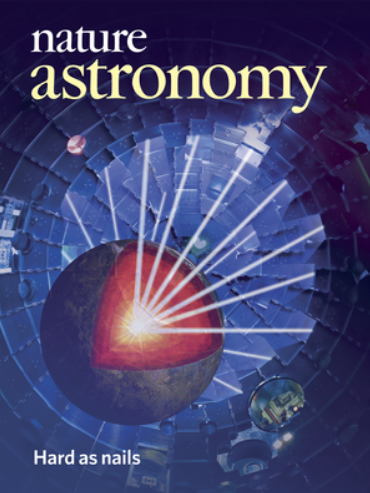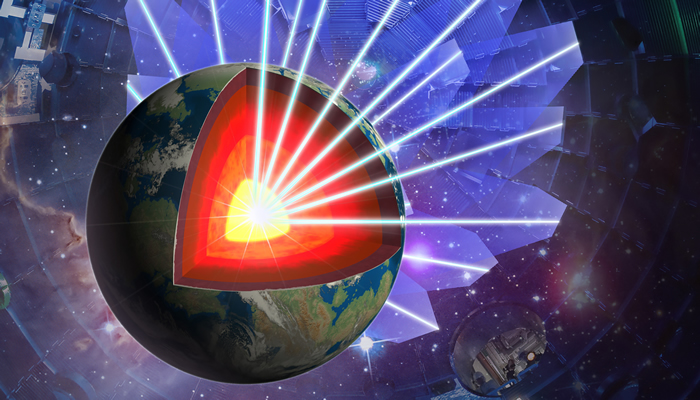Papers and Presentations - 2018
April
Laser Experiments Shed New Light on Supernova Physics
Squeezing Iron for Clues About ‘Super-Earth’ Cores
Record Experiments Probe Exoplanetary Cores
High-powered laser beams have compressed iron-silicon alloys to unprecedented pressures corresponding to the center of an extrasolar planet three times more massive than Earth. The resulting measurements of crystal structure and density provide new clues about the nature of the deep interiors of the large, Earth-like planets recently discovered throughout our galaxy.
The research, reported on April 25 in Science Advances, was led by June Wicks, assistant professor at Johns Hopkins University, with colleagues from LLNL, Princeton University, and the University of Rochester.
 This artist’s conception depicts one possible appearance of the planet Kepler-452b, the first near-Earth-size world to be found in the habitable zone of a star that is similar to our sun. The habitable zone is a region around a star where temperatures are right for water—an essential ingredient for life as we know it—to pool on the surface. Scientists do not know if Kepler-452b can support life or not. What is known about the planet is that it is about 60 percent larger than Earth, placing it in a class of planets dubbed “super-Earths.” The planet’s star is about 1,400 light-years away in the constellation Cygnus. Credit: NASA Ames/JPL-Caltech/T. Pyle
This artist’s conception depicts one possible appearance of the planet Kepler-452b, the first near-Earth-size world to be found in the habitable zone of a star that is similar to our sun. The habitable zone is a region around a star where temperatures are right for water—an essential ingredient for life as we know it—to pool on the surface. Scientists do not know if Kepler-452b can support life or not. What is known about the planet is that it is about 60 percent larger than Earth, placing it in a class of planets dubbed “super-Earths.” The planet’s star is about 1,400 light-years away in the constellation Cygnus. Credit: NASA Ames/JPL-Caltech/T. Pyle Of the thousands of planets now known to orbit other stars in our galaxy, those with sizes ranging between Earth and Neptune are among the most abundant. These planets have attracted much attention because there are no direct analogues for them in our own solar system and they provide insights into the types of possible planetary architectures that may exist in our galaxy. The interior pressures in such planets, however, can reach up to 10 times or more the pressure at the center of the Earth. These conditions are beyond the range of conventional experimental techniques, leaving the structure and composition of the interior of such bodies largely unknown.
The researchers were able to reach ultra-high pressures—more than 13 million Earth atmospheres—by compressing the iron-silicon alloy using the OMEGA laser at the University of Rochester’s Laboratory for Laser Energetics. This is more than three times the pressure at the center of the Earth and constitutes the highest x-ray diffraction measurements ever reported. The sample was compressed for only a few billionths of a second, but this was enough for the researchers to probe the atomic structure of the sample using a pulse of bright x rays.
“From cosmochemical and geophysical constraints, we know that the Earth’s core is composed of iron alloyed with about 10 percent lighter elements,” Wicks said. “The abundance and identification of light core elements are crucial for constraining the bulk chemistry of the Earth, the process of core formation and its subsequent thermal and magnetic evolution. A number of lines of evidence make silicon a likely candidate for a major element of the core on Earth and for large rocky extrasolar planets.”
The team examined two iron alloys with different silicon contents. The samples were studied by directing short but intense laser beams onto the sample. While the sample was compressed, an x-ray pulse was directed through it and the resulting diffraction pattern provided information on the density and crystal structure of the alloys. The researchers found the crystal structure changed at higher silicon content.
“Knowledge of the crystal structure is the most fundamental piece of information about the material making up the interior of a planet, as all other physical and chemical properties follow from the crystal structure,” Wicks said.
 The inside of the target chamber at the OMEGA Laser at the University of Rochester’s Laboratory for Laser Energetics (LLE), where lasers are used to compress iron-silicon samples to the ultra-high pressure conditions of exoplanetary cores. Credit: LLE
The inside of the target chamber at the OMEGA Laser at the University of Rochester’s Laboratory for Laser Energetics (LLE), where lasers are used to compress iron-silicon samples to the ultra-high pressure conditions of exoplanetary cores. Credit: LLE Along with the structure, the researchers measured the density of the iron-silicon alloys over a range of pressures encompassing those expected at the center of Earth to those at the center of a planet three times more massive than Earth. They found that at the highest pressures, the iron-silicon alloys reach a density of 18 grams per cubic centimeter—50 percent denser than that of pure lead at ambient conditions. The presence of silicon, however, lowers the density compared to that expected for pure iron.
The pressures achieved in this study are about three times higher than previous experiments on iron-silicon alloys, thus avoiding the need for long extrapolations in modeling the interior structure of large, rocky exoplanets. The researchers used their results to calculate the density and pressure distribution within exoplanet interiors, considering the presence of silicon in the core for the first time. The effect of silicon incorporation is to increase the size of the core but reduce its central pressure.
“A pure iron core is not realistic,” said Raymond Smith, lead researcher from LLNL, “as the process of planetary formation will inevitably lead to the incorporation of significant amounts of lighter elements. Our study is the first to consider these more realistic core compositions.”
Future research will be directed toward understanding how other candidate elements such as carbon or sulfur will affect the structure and density of iron at ultrahigh pressure conditions, as well as measuring other key physical properties of iron alloys needed to constrain plausible models of planetary interior structure and evolution.
The research was funded by the National Laser User Facilities Program of the National Nuclear Security Administration.
Co-authors of the paper include Dayne Fratanduono, Federica Coppari, Richard Kraus and Jon Eggert from LLNL; Thomas Duffy from Princeton University; Matthew Newman from Caltech; and Ryan Rygg and Rip Collins from the University of Rochester.
—Breanna Bishop
Laser Experiments Shed New Light on Supernova Physics
NIF Discovery Science experiments are providing scientists with new insights into the turbulent after-effects of a supernova explosion. The studies also could inform efforts to achieve self-sustaining nuclear fusion on NIF and other high-energy laser systems.
When stars of a certain mass collapse and then violently explode, material called ejecta expands rapidly and then decelerates as it interacts with the surrounding circumstellar medium. This results in Rayleigh–Taylor (RT) hydrodynamic instabilities—the mixing of denser with less-dense material.
 False-color Chandra X-ray Observatory image of supernova remnant E0102.2-72, the spectacular remains of a core-collapse supernova located about 190,000 light-years away in the Small Megallanic Cloud in the constellation Tucana. The expanding multimillion-degree remnant is about 30 light-years across. What appear to be Rayleigh-Taylor “spikes” can be seen in the outer edge of the expanding supernova remnant as the expanding envelope is decelerated by the circumstellar medium. Credit: (x-ray) NASA/CXC/MIT/D. Dewey et al. & NASA/CXC/SAO/J. DePasquale; (optical) NASA/STScI
False-color Chandra X-ray Observatory image of supernova remnant E0102.2-72, the spectacular remains of a core-collapse supernova located about 190,000 light-years away in the Small Megallanic Cloud in the constellation Tucana. The expanding multimillion-degree remnant is about 30 light-years across. What appear to be Rayleigh-Taylor “spikes” can be seen in the outer edge of the expanding supernova remnant as the expanding envelope is decelerated by the circumstellar medium. Credit: (x-ray) NASA/CXC/MIT/D. Dewey et al. & NASA/CXC/SAO/J. DePasquale; (optical) NASA/STScI The same instabilities can affect the performance of inertial confinement fusion (ICF) and high energy density (HED) science experiments such as those conducted on NIF, the world’s highest-energy laser system. The instabilities can cause too much target capsule material to mix with the fuel, quenching the fusion reaction.
The supernova studies, conducted by an international team of researchers led by the University of Michigan (U-M) and LLNL physicists Hye-Sook Park and Channing Huntington, found that high energy fluxes and the resulting heat could reduce RT growth in supernova remnants (SNRs)—something previous astrophysics models had not considered. The results were reported in a Nature Communications paper published online on April 19.
“Rayleigh-Taylor instabilities have been studied for over 100 years,” said Carolyn Kuranz, director of U-M’s Center for Laser Experimental Astrophysical Research and an associate research scientist of climate and space sciences and engineering. “These instabilities are important in supernova dynamics, but the effects of these high energy fluxes, these mechanisms that cause heating, have never been studied in this context.” The researchers said realistic models of SNRs “must account for the effects of thermal conduction to accurately predict their evolution at epochs immediately following the shock breakout.”
“These heating mechanisms reduce mixing and can have a dramatic effect on the evolution of a supernova,” Kuranz said. “In our experiment, we found that mixing was reduced by 30 percent and that reduction could continue to increase over time.”
That finding is potentially important for NIF because “the Rayleigh-Taylor instability is a very basic ingredient in understanding NIF’s performance,” Park said. “The effect of large energy flux and the basic science of the RT theory and application are quite relevant to ICF and HED science.”
Involving NIF Users
The supernova studies originated shortly after NIF became operational as a way to begin involving academic institutions in NIF experiments—an effort that has grown into the current Discovery Science program in which external institutions compete for time on NIF to conduct experimental campaigns (see “NIF Users Bring Ideas and Energy to Discovery Science”).
“We designed that experiment way back in 2009,” Park said. “This is one of the original Discovery Science programs—the first one, actually. The University of Michigan was doing supernova RT (SNRT) experiments on OMEGA (the OMEGA Laser at the University of Rochester), so we decided we could think of a similar experiment, but with a new physics goal, on NIF.”
U-M was studying RT instabilities in the context of the cosmic shocks produced by supernova explosions, “and NIF is really good at generating high-energy fluxes, using the hohlraum (the cylindrical target used in NIF ICF experiments), that are transported via thermal heat conduction and radiation transport—that’s one of the things that we can do easily,” Park said.
“So the idea was to study the effect of high-energy flux on RT growth that may be important to supernova evolution. Using NIF, we decided to study the difference in RT growth between the low-flux (230-electron-volt, or eV) and high-flux (325-eV) radiation drive cases.”
There were setbacks in the early years, however; NIF diagnostics at the time weren’t up to the task of providing the data required by the researchers. “A 325-eV hohlraum is really hot (about 3.8 million degrees Centigrade), generating a huge amount of background ‘noise’,” Park said. “A typical ICF deuterium-tritium (fusion) shot uses about 290 eV (3.4 million degrees C). Our 325-eV hohlraum is 400,000 degrees hotter. So our signal from our initial experiment got swamped by the background on the time-integrating x-ray film.”
The experiments regained momentum when Park became aware of a new experimental platform developed by Los Alamos National Laboratory (LANL) (see “‘Shock/Shear’ Experiments Shed Light on Turbulent Mix”). “We designed a target to fit in the halfraum (the half-hohlraum used in the shock/shear experiments),” Park said, “and we did a first set of experiments with a low-flux drive.
 (a) Schematic of the NIF SNRT target; laser beams incident on the gold hohlraum create the x-ray drive while additional beams impact the large-area backlighter to create the diagnostic x-ray source. A plastic shock tube is attached to the hohlraum. The soft x-rays from the hohlraum create a shock wave in the plastic layer inside the shock tube (b), which decays into a blast wave before crossing the unstable interface and entering the foam. The diagnostic x-ray source creates radiographs by being preferentially absorbed by a tracer layer in the center of the plastic. (c and d) X-ray radiographs of the experiment; the plasma flows upward, and the dark fingers are due to RT instability growth. The color bar indicates the relative transmission for (c) the high-flux case taken at 13 nanoseconds and (d) the low-flux case at 34 nanoseconds. The high-flux case shows significantly lower RT growth.
(a) Schematic of the NIF SNRT target; laser beams incident on the gold hohlraum create the x-ray drive while additional beams impact the large-area backlighter to create the diagnostic x-ray source. A plastic shock tube is attached to the hohlraum. The soft x-rays from the hohlraum create a shock wave in the plastic layer inside the shock tube (b), which decays into a blast wave before crossing the unstable interface and entering the foam. The diagnostic x-ray source creates radiographs by being preferentially absorbed by a tracer layer in the center of the plastic. (c and d) X-ray radiographs of the experiment; the plasma flows upward, and the dark fingers are due to RT instability growth. The color bar indicates the relative transmission for (c) the high-flux case taken at 13 nanoseconds and (d) the low-flux case at 34 nanoseconds. The high-flux case shows significantly lower RT growth. “We got great data with the low-flux hohlraum,” she said, “but we also needed to do a high-flux drive case with which to compare it; the experiment is all about comparing low drive and high drive. This (shock/shear) platform was never done at high drive, and unless you carefully design the target it wouldn’t work. We had to incorporate additional features to generate a high-flux drive that didn’t generate significant background and that didn’t hamper our observations.”
With a new target designed and deployed, the researchers were able to conduct a successful series of nine shots using both low-flux and high-flux drives that demonstrated the effect of high-flux radiation on the subsequent RT growth. They then used the results to explore how the large energy fluxes present in supernovae could affect the structure of SNRs and Rayleigh–Taylor growth.
“In analyzing the comparison with supernova SN1993J, a Type II supernova,” they said, “we found that the energy fluxes produced by heat conduction appear to be larger than the radiative energy fluxes, and large enough to have dramatic consequences.”
Park said future experiments in the campaign will attempt to measure the temperature and density in the shock-formation region. “Then we can be more creative about creating more heat flux in the NIF environment to more closely mimic the astrophysical conditions,” she said. “There are a lot of windows of opportunity.”
 Members of the team studying supernova remnants on NIF (from left): NIF Operations Manager Bruno Van Wonterghem, Channing Huntington, Bruce Remington, Carolyn Kuranz, Kirk Flippo, and Hye-Sook Park.
Members of the team studying supernova remnants on NIF (from left): NIF Operations Manager Bruno Van Wonterghem, Channing Huntington, Bruce Remington, Carolyn Kuranz, Kirk Flippo, and Hye-Sook Park. Joining Kuranz, Park, and Huntington on the paper were Aaron Miles, Bruce Remington, Harry Robey, Kumar Raman, Steve MacLaren, Shon Prisbrey, Russell Wallace, and Dan Kalantar from LLNL along with John Kline, Kirk Flippo, Willow Wan, and Forrest Doss from LANL, Eric Harding from Sandia National Laboratories, Christine Krauland and Emilio Giraldez from General Atomics, and researchers from U-M, Florida State University, Ben Gurion University of the Negev in Israel, and Simon Fraser University in Canada.
—Charlie Osolin
Squeezing Iron for Clues About ‘Super-Earth’ Cores
Iron-compression experiments on NIF have provided new insights into the possible interior structure and composition of large, rocky exoplanets known as “super-Earths.” The findings could help in developing new models of planetary interiors.
 Cover of the June 2018 issue of Nature Astronomy. Credit (Image): Mark Meamber/LLNL. Cover Design: Bethany Vukomanovic
Cover of the June 2018 issue of Nature Astronomy. Credit (Image): Mark Meamber/LLNL. Cover Design: Bethany Vukomanovic The research by a team of scientists from LLNL, Princeton University, Johns Hopkins University, and the University of Rochester was reported in a Nature Astronomy cover article published online on April 16.
“The discovery of large numbers of planets outside our solar system has been one of the most exciting scientific discoveries of this generation,” said LLNL physicist Ray Smith, lead author of the paper. “These discoveries raise fundamental questions: What are the different types of extrasolar planets and how do they form and evolve? Which of these objects can potentially sustain surface conditions suitable for life? To address such questions, it is necessary to understand the composition and interior structure of these objects.”
Of the more than 4,000 confirmed and candidate extrasolar planets, those that are one to four times the radius of Earth are now known to be the most abundant. “Determining the interior structure and composition of these super-Earth planets is challenging,” Smith said, “but is crucial to understanding the diversity and evolution of planetary systems within our galaxy.”
As core pressures for a planet with five times the mass of Earth can reach as high as 20 million atmospheres, a fundamental requirement for understanding exoplanetary composition and interior structure is an accurate determination of the material properties at these extreme pressures. Iron is an abundant element in the universe and, as the dominant constituent of terrestrial planetary cores, is a key material for studying super-Earth interiors. A detailed understanding of the properties of iron at super-Earth conditions is an essential component of the team’s experiments.
 Artist’s illustration of the potentially life-supporting “super-Earth” planet K2-18b (upper right) and its recently discovered neighbor, K2-18c. Both planets orbit in the habitable zone of the red-dwarf star K2-18, which lies 111 light-years from Earth in the constellation Leo. K2-18b, about 2.2 times bigger than Earth, was discovered in 2015 by researchers using NASA’s Kepler space telescope. Credit: Alex Boersma
Artist’s illustration of the potentially life-supporting “super-Earth” planet K2-18b (upper right) and its recently discovered neighbor, K2-18c. Both planets orbit in the habitable zone of the red-dwarf star K2-18, which lies 111 light-years from Earth in the constellation Leo. K2-18b, about 2.2 times bigger than Earth, was discovered in 2015 by researchers using NASA’s Kepler space telescope. Credit: Alex Boersma In their paper, the researchers describe a new generation of high-power laser experiments which use ramp, or shockless, compression techniques to provide the first absolute equation-of-state measurements of iron at the extreme pressure and density conditions found within super-Earth cores. Shock-free dynamic compression is uniquely suited for compressing matter with minimal heating to terapascal (TPa) pressures (1 TPa=10 million atmospheres).
Interpreting Observational Data
The experiments produced the first experimentally based mass-radius relationship for a hypothetical pure iron planet at super-Earth core conditions. The discovery can form the basis for future planetary interior models, which in turn can be used to more accurately interpret observational data from the Kepler space telescope and aid in identifying planets suitable for habitability.
NIF, the world’s largest and highest-energy laser, can deliver up to two million joules of laser energy over 30 nanoseconds (billionths of a second) and can provide the necessary laser power and control to ramp-compress materials to TPa pressures. The team’s experiments reached peak pressures of 1.4 TPa, four times higher than previous static results, representing core conditions found in a planet with three to four times the mass of Earth.

“Planetary interior models, which rely on a description of constituent materials under extreme pressures, are commonly based on extrapolations of low-pressure data and produce a wide range of predicated material states,” Smith said. “Our experimental data provides a firmer basis for establishing the properties of a super-Earth planet with a pure iron core.
“Furthermore,” he added, “our study demonstrates the capability for determination of equations of state and other key thermodynamic properties of planetary core materials at pressures well beyond those of conventional static techniques. Such information is crucial for advancing our understanding of the structure and dynamics of large rocky exoplanets and their evolution.”
Future experiments on NIF will extend the study of planetary materials to several TPa while combining nanosecond x-ray diffraction techniques to determine crystal structure evolution as pressure increases.
Smith was joined on the paper by LLNL colleagues Dayne Fratanduono, David Braun, Peter Celliers, Suzanne Ali, Amalia Fernandez-Pañella, Richard Kraus, Damian Swift and Jon Eggert, along with Thomas Duffy from Princeton University, June Wicks from Johns Hopkins University, and Rip Collins from the Laboratory for Laser Energetics at the University of Rochester.
—Breanna Bishop




